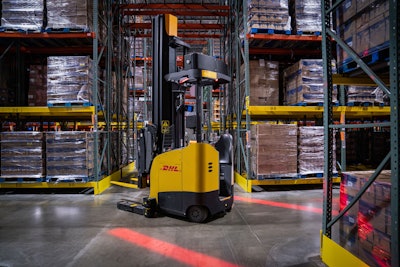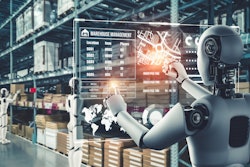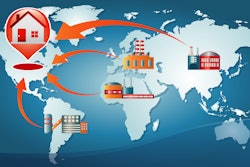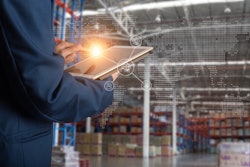
Digitalizing the supply chain is the future. But, getting there takes automation and emerging technology. It requires investing in solutions designed to track and trace, produce data analytics and deliver real-time alerts when parts of the supply chain fall off track. It requires buy-in from all decision-makers to help build the supply chain of tomorrow.
And, it’s this automation and emerging technology that helps the cold food chain build the supply chain of tomorrow.
In Food Logistics’ March/April 2022 issue, editor-in-chief Marina Mayer talks with several industry experts about warehouse automation and how automation and emerging technology future-proof supply chains.
Here’s an interview with Greg Foreman, VP of operations, retail, DHL Supply Chain, details why fostering a culture of continuous innovation is necessary in leveraging automation, with excerpts publishing in Food Logistics’ March/April 2022 issue. [CLICK HERE to read the article in full].
Food Logistics: From your perspective, what are some of the top challenges today’s cold food chains face?
Greg Foreman: Today’s cold food chains are dealing with a combination of familiar and new challenges. Some, such as port congestion, are expected to clear up by mid-2022, while others, such as transportation woes, are longer-term issues that will likely continue. Difficulty attracting labor (drivers and warehouse workers), equipment and infrastructure procurement lead times and volatility of product demand with changing consumer habits have also combined to put real pressure on labor and assets.
Food Logistics: How can warehouse automation help overcome these challenges?
Foreman: At DHL Supply Chain, we are accelerating our digitalization efforts and working to maximize the use of automation across verticals to help our customers grow and achieve their business objectives while managing resources often in short supply. Examples include our use of collaborative robots, which eliminate routine tasks such as moving between picking locations in a warehouse, and autonomous forklifts, announced late last year, which automate some of the heavy-lifting activity. These technologies boost productivity, allowing us to process higher volumes with the same labor resources and space, offsetting some of the hiring challenges while improving the safety and well-being of our associates who enjoy working with this advanced technology.
We also just recently announced a $15 million investment in robotics solutions from Boston Dynamics to further automate warehousing in North America. The agreement will equip DHL facilities with Stretch, Boston Dynamics’ newest robot specifically designed to automate the unloading process in distribution centers.
Food Logistics: The warehouse automation market is expected to grow to $27 billion by 2025; twice the size it was roughly five years ago, according to Research and Markets. To what do you attribute this growth to?
Foreman: The warehouse flow is critical to companies’ revenue stream and thus labor availability has shot to the top of the list of areas that have benefited from automation. Automation enables workers to offload more repeatable and mundane tasks, which frees them up to engage in more strategic and innovative work. At DHL, we’ve found this is a big benefit and something our associates really appreciate. We also continue incorporate emerging technologies into our customers’ operations to offset some of the challenges with volume surges, driving productivity and cost improvements for them. All these factors are likely contributing to this spike.
Food Logistics: There are many different types of automated warehousing solutions. What kinds of emerging warehouse automation technologies do you see continuing to make an impact on the industry?
Foreman: Part of fostering a culture of continuous innovation is investing in a team that stays on top of all the latest emerging technologies all the time. Our scouts are continuously evaluating companies and their associated technologies to determine which can best support our customers’ continuous improvement goals. Each customer is going to leverage a different set of automated solutions based on their operations, but in terms of the broad automated warehousing solutions that are making an impact, I believe they are technologies like indoor robotic transport, wearables, algorithmic optimization and machine learning, robot-assisted inventory management and asset tracking and monitoring, just to name a few.
Food Logistics: What advice do you have for those companies still struggling to adopt warehouse automation? Where do you envision the hang-ups being and why?
Foreman: It’s a crowded field of options for those interested in integrating more automation across their operations, which can be overwhelming for many companies who don’t know where to start. And though many suppliers have great solutions, the solution by itself is not enough. We take a more holistic approach with our clients, beginning with the existing client’s business data and an engineering analysis, which leads us to the best technology solutions for their specific operations. We can help customers to ready their operations to adopt new technologies, as well as to integrate them gradually to reduce upfront investment costs, risks and operational challenges. The added benefit of our experience in operating automation lends credence to return on investment (ROI) projections and we can offer scale opportunities across multiple regions if a technology fits our customers’ requirements.
Food Logistics: What are some things not addressed above that may be pertinent to our readers regarding warehouse automation in food logistics?
Foreman: Companies must examine internal resources to determine whether they have the talent to manage large automation projects. These resources may not exist internally and turning to consultants can be expensive. Partnering with providers who have the necessary experience and are continuing to stay on top of emerging technologies will provide a tremendous benefit as you embark on your automation journey.
[CLICK HERE to read the article in full].





















